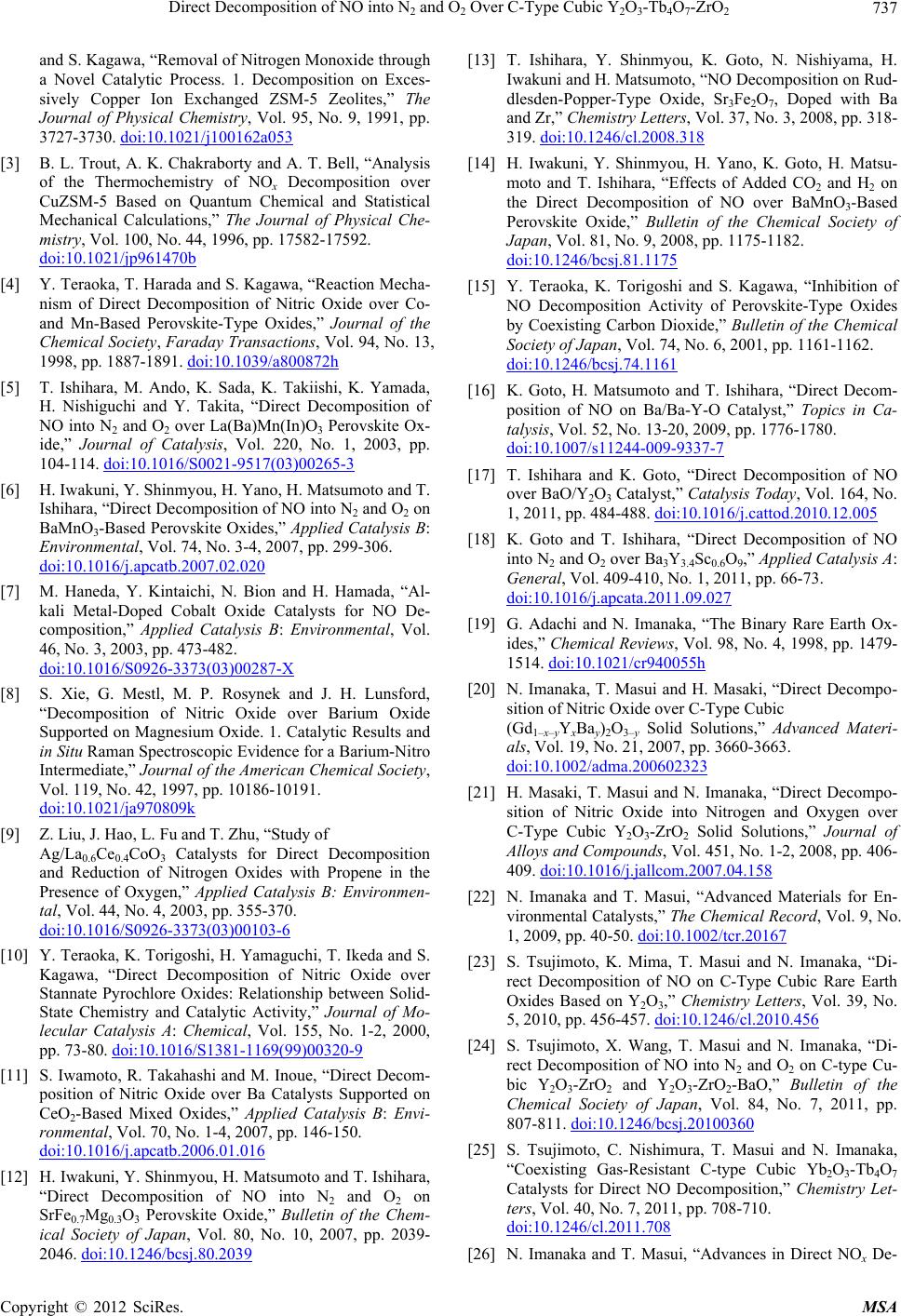
Direct Decomposition of NO into N2 and O2 Over C-Type Cubic Y2O3-Tb4O7-ZrO2 737
and S. Kagawa, “Removal of Nitrogen Monoxide through
a Novel Catalytic Process. 1. Decomposition on Exces-
sively Copper Ion Exchanged ZSM-5 Zeolites,” The
Journal of Physical Chemistry, Vol. 95, No. 9, 1991, pp.
3727-3730. doi:10.1021/j100162a053
[3] B. L. Trout, A. K. Chakraborty and A. T. Bell, “Analysis
of the Thermochemistry of NOx Decomposition over
CuZSM-5 Based on Quantum Chemical and Statistical
Mechanical Calculations,” The Journal of Physical Che-
mistry, Vol. 100, No. 44, 1996, pp. 17582-17592.
doi:10.1021/jp961470b
[4] Y. Teraoka, T. Harada and S. Kagawa, “Reaction Mecha-
nism of Direct Decomposition of Nitric Oxide over Co-
and Mn-Based Perovskite-Type Oxides,” Journal of the
Chemical Society, Faraday Transactions, Vol. 94, No. 13,
1998, pp. 1887-1891. doi:10.1039/a800872h
[5] T. Ishihara, M. Ando, K. Sada, K. Takiishi, K. Yamada,
H. Nishiguchi and Y. Takita, “Direct Decomposition of
NO into N2 and O2 over La(Ba)Mn(In)O3 Perovskite Ox-
ide,” Journal of Catalysis, Vol. 220, No. 1, 2003, pp.
104-114. doi:10.1016/S0021-9517(03)00265-3
[6] H. Iwakuni, Y. Shinmyou, H. Yano, H. Matsumoto and T.
Ishihara, “Direct Decomposition of NO into N2 and O2 on
BaMnO3-Based Perovskite Oxides,” Applied Catalysis B:
Environmental, Vol. 74, No. 3-4, 2007, pp. 299-306.
doi:10.1016/j.apcatb.2007.02.020
[7] M. Haneda, Y. Kintaichi, N. Bion and H. Hamada, “Al-
kali Metal-Doped Cobalt Oxide Catalysts for NO De-
composition,” Applied Catalysis B: Environmental, Vol.
46, No. 3, 2003, pp. 473-482.
doi:10.1016/S0926-3373(03)00287-X
[8] S. Xie, G. Mestl, M. P. Rosynek and J. H. Lunsford,
“Decomposition of Nitric Oxide over Barium Oxide
Supported on Magnesium Oxide. 1. Catalytic Results and
in Situ Raman Spectroscopic Evidence for a Barium-Nitro
Intermediate,” Journal of the American Chemical Society,
Vol. 119, No. 42, 1997, pp. 10186-10191.
doi:10.1021/ja970809k
[9] Z. Liu, J. Hao, L. Fu and T. Zhu, “Study of
Ag/La0.6Ce0.4CoO3 Catalysts for Direct Decomposition
and Reduction of Nitrogen Oxides with Propene in the
Presence of Oxygen,” Applied Catalysis B: Environmen-
tal, Vol. 44, No. 4, 2003, pp. 355-370.
doi:10.1016/S0926-3373(03)00103-6
[10] Y. Teraoka, K. Torigoshi, H. Yamaguchi, T. Ikeda and S.
Kagawa, “Direct Decomposition of Nitric Oxide over
Stannate Pyrochlore Oxides: Relationship between Solid-
State Chemistry and Catalytic Activity,” Journal of Mo-
lecular Catalysis A: Chemical, Vol. 155, No. 1-2, 2000,
pp. 73-80. doi:10.1016/S1381-1169(99)00320-9
[11] S. Iwamoto, R. Takahashi and M. Inoue, “Direct Decom-
position of Nitric Oxide over Ba Catalysts Supported on
CeO2-Based Mixed Oxides,” Applied Catalysis B: Envi-
ronmental, Vol. 70, No. 1-4, 2007, pp. 146-150.
doi:10.1016/j.apcatb.2006.01.016
[12] H. Iwakuni, Y. Shinmyou, H. Matsumoto and T. Ishihara,
“Direct Decomposition of NO into N2 and O2 on
SrFe0.7Mg0.3O3 Perovskite Oxide,” Bulletin of the Chem-
ical Society of Japan, Vol. 80, No. 10, 2007, pp. 2039-
2046. doi:10.1246/bcsj.80.2039
[13] T. Ishihara, Y. Shinmyou, K. Goto, N. Nishiyama, H.
Iwakuni and H. Matsumoto, “NO Decomposition on Rud-
dlesden-Popper-Type Oxide, Sr3Fe2O7, Doped with Ba
and Zr,” Chemistry Letters, Vol. 37, No. 3, 2008, pp. 318-
319. doi:10.1246/cl.2008.318
[14] H. Iwakuni, Y. Shinmyou, H. Yano, K. Goto, H. Matsu-
moto and T. Ishihara, “Effects of Added CO2 and H2 on
the Direct Decomposition of NO over BaMnO3-Based
Perovskite Oxide,” Bulletin of the Chemical Society of
Japan, Vol. 81, No. 9, 2008, pp. 1175-1182.
doi:10.1246/bcsj.81.1175
[15] Y. Teraoka, K. Torigoshi and S. Kagawa, “Inhibition of
NO Decomposition Activity of Perovskite-Type Oxides
by Coexisting Carbon Dioxide,” Bulletin of the Chemical
Society of Japan, Vol. 74, No. 6, 2001, pp. 1161-1162.
doi:10.1246/bcsj.74.1161
[16] K. Goto, H. Matsumoto and T. Ishihara, “Direct Decom-
position of NO on Ba/Ba-Y-O Catalyst,” Topics in Ca-
talysis, Vol. 52, No. 13-20, 2009, pp. 1776-1780.
doi:10.1007/s11244-009-9337-7
[17] T. Ishihara and K. Goto, “Direct Decomposition of NO
over BaO/Y2O3 Catalyst,” Catalysis Today, Vol. 164, No.
1, 2011, pp. 484-488. doi:10.1016/j.cattod.2010.12.005
[18] K. Goto and T. Ishihara, “Direct Decomposition of NO
into N2 and O2 over Ba3Y3.4Sc0.6O9,” Applied Catalysis A:
General, Vol. 409-410, No. 1, 2011, pp. 66-73.
doi:10.1016/j.apcata.2011.09.027
[19] G. Adachi and N. Imanaka, “The Binary Rare Earth Ox-
ides,” Chemical Reviews, Vol. 98, No. 4, 1998, pp. 1479-
1514. doi:10.1021/cr940055h
[20] N. Imanaka, T. Masui and H. Masaki, “Direct Decompo-
sition of Nitric Oxide over C-Type Cubic
(Gd1–x–yYxBay)2O3–y Solid Solutions,” Advanced Materi-
als, Vol. 19, No. 21, 2007, pp. 3660-3663.
doi:10.1002/adma.200602323
[21] H. Masaki, T. Masui and N. Imanaka, “Direct Decompo-
sition of Nitric Oxide into Nitrogen and Oxygen over
C-Type Cubic Y2O3-ZrO2 Solid Solutions,” Journal of
Alloys and Compounds, Vol. 451, No. 1-2, 2008, pp. 406-
409. doi:10.1016/j.jallcom.2007.04.158
[22] N. Imanaka and T. Masui, “Advanced Materials for En-
vironmental Catalysts,” The Chemical Record, Vol. 9, No.
1, 2009, pp. 40-50. doi:10.1002/tcr.20167
[23] S. Tsujimoto, K. Mima, T. Masui and N. Imanaka, “Di-
rect Decomposition of NO on C-Type Cubic Rare Earth
Oxides Based on Y2O3,” Chemistry Letters, Vol. 39, No.
5, 2010, pp. 456-457. doi:10.1246/cl.2010.456
[24] S. Tsujimoto, X. Wang, T. Masui and N. Imanaka, “Di-
rect Decomposition of NO into N2 and O2 on C-type Cu-
bic Y2O3-ZrO2 and Y2O3-ZrO2-BaO,” Bulletin of the
Chemical Society of Japan, Vol. 84, No. 7, 2011, pp.
807-811. doi:10.1246/bcsj.20100360
[25] S. Tsujimoto, C. Nishimura, T. Masui and N. Imanaka,
“Coexisting Gas-Resistant C-type Cubic Yb2O3-Tb4O7
Catalysts for Direct NO Decomposition,” Chemistry Let-
ters, Vol. 40, No. 7, 2011, pp. 708-710.
doi:10.1246/cl.2011.708
[26] N. Imanaka and T. Masui, “Advances in Direct NOx De-
Copyright © 2012 SciRes. MSA